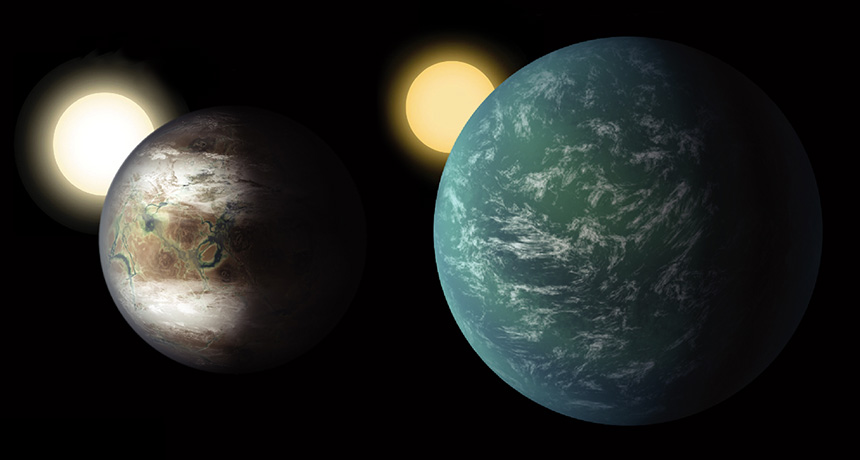Small, distant worlds are either big Earths or little Neptunes
Kepler telescope adds 10 potentially habitable rocky planets to exoplanets tally

The Kepler space telescope detected a lot of alien worlds that are rocky like Earth or gassy like Neptune. But few exist between those two types.
B.J. Fulton/Univ. of Hawaii, Caltech, Ames/NASA
Small worlds come in two flavors — super-Earths and mini-Neptunes.
This conclusion emerges from data collected by the Kepler space telescope. It was charged with hunting for alien planets, meaning those outside our solar system. Now Kepler’s initial mission is over and its data in-hand.
Scientists released Kepler’s final tally of so-called exoplanets June 19 at a news conference. The spacecraft has turned up 4,034 of these candidate planets. Among them are 49 rocky worlds, including 10 newly discovered ones. These sit in their stars’ Goldilocks zones. That means they fall within a region that’s not too hot and not too cold to support life as we know it. To date, 2,335 of the candidates have been confirmed as planets. That includes about 30 rocky worlds that are in potentially habitable zones.
Benjamin Fulton studies these alien worlds. He works at the University of Hawaii at Manoa and at the California Institute of Technology (Caltech) in Pasadena. He and his colleagues made careful measurements of the candidate planets’ stars. This turned up something unexpected. Few planets had a radius more than 1.5 times that of Earth but less than twice as big as Earth’s.
This split the planet into two types, based on size. Rocky ones, like Earth, had the smaller radii (under 1.5 times the size of Earth’s). Gassy planets (the Neptune-like ones) tended to have a radius that was from 2 to 3.5 times the size of Earth’s.
“This is a major new division in the family tree of exoplanets,” Fulton reports. It is “somewhat analogous to the discovery that mammals and lizards are separate branches on the tree of life,” he says.
The Kepler space telescope launched in 2009. It had one ultimate goal: to identify the fraction of stars like the sun that host planets like Earth. To do this, it stared at a single patch of sky in the constellation Cygnus for four years. Kepler watched sunlike stars for telltale dips in brightness. Such dips point to when a planet passes in front of its star. Known as a transit, one might think of it as a mini or partial-eclipse.
The Kepler team has still not yet calculated what share of the sun-like stars in Kepler’s eye host planets in the Goldilocks zone. But astronomers are confident that they finally have enough data to do so, said Susan Thompson. She is an astronomer at the SETI Institute in Mountain View, Calif. She presented the new data during the Kepler/K2 Science Conference IV being held at NASA’s Ames Research Center in Moffett Field, Calif. (K2 refers to Kepler’s second mission. It began when the telescope’s stabilizing reaction wheels broke.)
Thompson and her colleagues ran the Kepler dataset through “Robovetter” software. It acted like a sieve to catch all of the potential planets that the dataset contained. Running fake planet data through the software pinpointed how likely it was to confuse other signals for a planet or to miss true planets.
“This is the first time we have a population [of exoplanets] that’s really well-characterized,” Thompson says.
Astronomers’ knowledge of exoplanets is only as good as their knowledge of the planets’ host stars. So, in a separate study, Fulton and his colleagues turned to the Keck telescope in Hawaii. They used it to precisely measure the sizes of 1,300 planet-hosting stars that were in the Kepler telescope’s field of view. That let them compare the dips in light due to a planet crossing in front of its star to that star’s real size. Those star sizes helped pin down the sizes of the planets with four times more precision than ever before.
The split in planet types the team found could come from small differences in the planets’ sizes, compositions and distances from their stars. Young stars emit powerful winds of charged particles. These winds can blow a growing planet’s atmosphere away.
Bigger planets have more gravity, which helps them hold on to a thicker atmosphere. If a planet was too close to its star or too small to hold its atmosphere tightly — less than 75 percent larger than Earth — it would lose its atmosphere and end up in the smaller group. The planets that look more like Neptune today either had more gas to begin with. Or, they grew up in a gentler environment, Fulton now concludes.
That split could have implications for the abundance of life in the Milky Way. That’s our galaxy. Consider the surfaces of mini-Neptunes, if they exist. They would suffer under the crushing pressure of a thick atmosphere.
“These would not be nice places to live,” Fulton said. “Our result sharpens up the dividing line between potentially habitable planets and those that are inhospitable.”
Better telescopes will sharpen the dividing line even further. Two such telescopes are slated to launch in 2018. The Transiting Exoplanet Survey Satellite will fill in the details of the exoplanet landscape with more observations of planets around bright stars. The James Webb Space Telescope will be able to check the atmospheres of those planets for signs of life.
“We can now really ask the question, ‘Is our planetary system unique in the galaxy?’” says Courtney Dressing. She is an exoplanet astronomer at Caltech. “My guess is the answer’s no. We’re not that special.”







